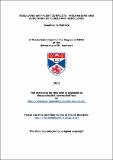Files in this item
Resolving ant-plant conflicts : mechanisms and functions of floral ant-repellence
Item metadata
| dc.contributor.advisor | Willmer, Pat | |
| dc.contributor.author | Pattrick, Jonathan G. | |
| dc.coverage.spatial | iv, 69 | en_US |
| dc.date.accessioned | 2012-10-23T13:54:58Z | |
| dc.date.available | 2012-10-23T13:54:58Z | |
| dc.date.issued | 2012-06-19 | |
| dc.identifier.uri | https://hdl.handle.net/10023/3214 | |
| dc.description.abstract | Although ants have numerous, often beneficial interactions with plants, as pollinators they are poor. Potential reasons for this include restrictions resulting from their morphology and specific foraging behaviours, and detrimental effects of their surface secretions on pollen. This, coupled with other possible negative effects of ants on floral structures, puts pressure on plants to exclude ants from flowers. One common strategy to achieve this is via behaviour-modifying repellent floral volatiles; however, few studies have identified the volatiles concerned. Here I considered two aspects of this interaction. Firstly, I assessed seven temperate angiosperm species for floral repellence to Formica aquilonia ants using a simple two-way olfactometer. In agreement with previous studies showing that floral ant-repellence is common, significant repellent effects were found in 3/7 species. I also analysed the floral bouquet of Petasites fragrans, a plant previously shown to possess ant-repellent floral volatiles. The most prominent volatile was identified as 4-methoxybenzaldehyde and olfactometer testing of a pure sample of this confirmed it as the likely source of floral repellence in P. fragrans. Although the natural interactions between P. fragrans and ants are unknown, intriguingly 4-methoxybenzaldehyde has been detected from floral volatiles of two further species with frequent ant interactions. A second study compared effects of ants and bees on pollen function to explore the supposed significance of ant-induced reductions in pollen viability. Lily pollen was exposed to either F. aquilonia, Apis mellifera, or Bombus pascuorum, germinated in vitro and assessed for viability. Small, marginally significant reductions in viability were identified for all three insects compared to a control, but with no differences in the reduction between each insect. Although this indicates that the pollen inviability hypothesis for the scarcity of ant pollination may be incorrect, a comparative study with several pollinator and plant species is needed to substantiate this conclusion. | en_US |
| dc.language.iso | en | en_US |
| dc.subject.lcc | QK921.P2 | en_US |
| dc.subject.lcsh | Plant defenses | en_US |
| dc.subject.lcsh | Insect-plant relationships | en_US |
| dc.subject.lcsh | Flowers--Odor | en_US |
| dc.subject.lcsh | Ants--Behavior | en_US |
| dc.title | Resolving ant-plant conflicts : mechanisms and functions of floral ant-repellence | en_US |
| dc.type | Thesis | en_US |
| dc.type.qualificationlevel | Doctoral | en_US |
| dc.type.qualificationname | MPhil Master of Philosophy | en_US |
| dc.publisher.institution | The University of St Andrews | en_US |
This item appears in the following Collection(s)
Items in the St Andrews Research Repository are protected by copyright, with all rights reserved, unless otherwise indicated.


